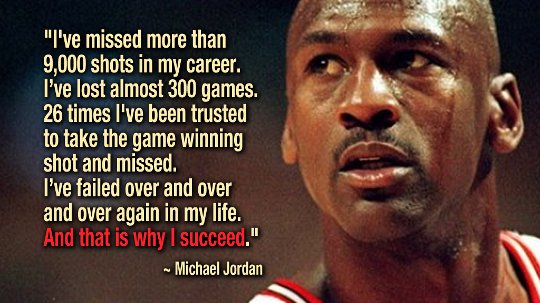
We do not teach people how to fail in our education system. From the earliest grades, our schools are focused on success. The purpose of exams is to get questions correct. The people who are rewarded in school are the ones who get the best grades, not the ones who take the biggest risks or the ones who learn from their mistakes.
Eventually, though, everyone fails. It is just not possible to do anything new and interesting without failing at least some of the time. It is the ability to learn from a failure and to do better that is the key to success in any venture. The scientist and poet Piet Hein wrote short verses that he called grooks. One of his most famous grooks was called “The Road to Wisdom,” and it reads:
Well, it’s plain
and simple to express.
Err and err and err again,
but less and less and less.
As this verse suggests, the key to wisdom is not succeeding, but learning from your mistakes in ways that allow the mistakes you make in the future less damaging than the ones you made in the past.
Learning the Art of Self-Compassion
You need to take the proper orientation toward failure. You have to learn the art of self-compassion—treating yourself with warmth and understanding. You can set high expectations, but you should not punish yourself when you fail.
This concept might sound similar to the related idea of self-esteem. Self-esteem refers to the ability to think positively about yourself. It is important for people to think that they are valuable and to believe that they have the capacity to contribute to the world. Self-esteem helps give people the confidence to present themselves in public settings and to make sure that they are treated fairly.
But self-compassion goes beyond self-esteem because it is focused on your response to failure. It relates to your beliefs about what failure tells you about yourself.
The Entity Mind-Set and the Incremental Mind-Set
Carol Dweck and her colleagues’ research explored the difference between two kinds of mind-sets. The entity mind-set assumes that a particular characteristic is an unchangeable part of who you are. The incremental mind-set assumes that some aspect of yourself can be changed with enough effort.
Self-compassion involves taking an incremental mind-set about the source of your failure. If you have a high-degree of self- compassion, you look at your failures and believe they reflect a combination of the actions you took, the situation that occurred, and other factors that may have been out of your control. The key, though, is that you recognize that you can change your own behavior in the future and lower the probability of failing again.
If you don’t have self-compassion, then you’re taking an entity mind-set about failure. When you fail, you assume that failure is telling you something fundamental about yourself. The failure points out your limits. If you come to believe that failures are things that you cannot overcome, then your response to failure is to give up. Without self-compassion, you start to accept that there are some changes you cannot make.
Being Patient and Persistent with Your Motivational System
There is a good chance you have failed in some of your attempts to change your behavior in the past. You may even believe you are not the sort of person who can change.
The reason some behaviors are so hard to change is that your motivational system is exquisitely organized to help you achieve your goals. This system wants you to be able to act without thinking as much as possible. Making radical changes to your behavior is hard precisely because this system is so effective.
But your motivational system learned the behaviors you’re trying to change. And so it can also learn the new behaviors you’re trying to incorporate into your life. Your motivational system can and will adapt to the new behaviors you want to create, though it will take time.
On the Days That You Fail...
There will be days you will fail. You will eat too much, smoke a cigarette, skip your homework, avoid practicing your instrument, or get angry at a coworker. You have to meet those failures with self-compassion. Failing on a particular day is not a sign that you cannot change. It’s a sign that your motivational system is still being efficient at promoting the behaviors you want to change.
But you have all of the tools to make the contribution you ultimately want. A few small failures may indicate that you need some more time to let the process of change reprogram your Go System. In that case, be patient and let your plan unfold.
If you fail systematically, though, then you want to go back and start to diagnose the problem. What are the situations that are causing you to fail? Where are you when that happens? With whom are you spending time with?
As you begin to understand where these failures occur, think about the tools you can use to help you get beyond those failures. Do you need to reorient your goals to create a different set of achievements? Are there steps missing in your implementation intention that require you to revise your plan? Are there situations in which you are trying to rely too heavily on willpower to get yourself beyond temptations? Are there aspects of your environment that are pushing you toward behaviors you would prefer to avoid? Are there people in your neighborhood whom you ought to engage to help you act differently?
Self-compassion means accepting that failure is a signal you need to do some more work. So trust in the process. In the end, you can change your behavior.
Get to work.
From A Thinking Mind-Set To A Doing Mind-Set
You have to flip yourself from a thinking mind-set to a doing mind-set. To make that happen, start to engage yourself in the world. Bring yourself mentally nearer to the behaviors you want to change. If you are someone who prefers an action mind-set, then you have probably been champing at the bit to get started for a while now. Be cautious, however, and make sure your plan for change is well established.
If you are more prone to procrastination, though, then you may need some help getting started. Make changes in your environment and engage your neighbors to allow you to start doing things to initiate changes in your behavior.
Once you get started changing your behavior, you will discover the process of change is dynamic. The strategies that worked in the first week of your new program of Smart Change may not be so effective a month later or even a year later. Behavior change is a process that unfolds over time.
Changing Your Focus
At the early stage of behavior change, it is often motivating enough just to focus on the progress you have made so far. You can also get a lot out of the mentors and partners you find in your neighborhood.
Soon, though, it becomes hard to see your progress. You are probably still moving forward toward your contribution, but it can be difficult to see the changes. In the middle stage, create some landmarks to provide continued motivation. Consider using a commitment contract if you are having trouble sticking to the plan. Engage your neighbors to continue implementing your plan. Start looking toward the outcomes you desire. As those outcomes get closer, they may be more motivating to you than the distance you have traveled since you started changing your behavior.
Resist the temptation to disengage with your neighbors and to treat them as competitors. Instead, consider becoming a mentor to others. Share your experience and continue the conversation with your neighbors. That will help you understand your own process of change.
Finally, treat yourself with compassion. The old adage says that change involves two steps forward and one step back. On the days when you feel as if you have taken a step back, remember these little failures are not telling you that change is impossible. They may be signals that your plan needs to be revised.
Keep track of your successes and failures in your Smart Change Journal and use that information to help you think about ways to use the tools for change in new ways to help you overcome the obstacles you face.
©2014 by Art Markman PhD.
Reprinted with permission of the publisher,
The Penguin Group/Perigee. www.penguin.com
Article Source:
 Smart Change: Five Tools to Create New and Sustainable Habits in Yourself and Others
Smart Change: Five Tools to Create New and Sustainable Habits in Yourself and Others
by Art Markman PhD.
Click here for more info and/or to order this book.
About the Author
 Art Markman, PhD, the author of Smart Thinking and Habits of Leadership, is the Annabel Irion Worsham Centennial Professor of Psychology and Marketing at the University of Texas and founding director of the program in the Human Dimensions of Organizations. As a consultant he has worked with large companies, including Procter & Gamble, for which he developed a number of training programs. He has worked with Drs Mehmet Oz and Michael Roizen on two of their bestselling You books and contributes to their social networking website, YouBeauty. He is also on the scientific advisory boards for The Dr. Phil Show and The Dr. Oz Show. Art Markman blogs regularly for Psychology Today, the Huffington Post, 99U, and Harvard Business Review online. Visit him on Facebook.
Art Markman, PhD, the author of Smart Thinking and Habits of Leadership, is the Annabel Irion Worsham Centennial Professor of Psychology and Marketing at the University of Texas and founding director of the program in the Human Dimensions of Organizations. As a consultant he has worked with large companies, including Procter & Gamble, for which he developed a number of training programs. He has worked with Drs Mehmet Oz and Michael Roizen on two of their bestselling You books and contributes to their social networking website, YouBeauty. He is also on the scientific advisory boards for The Dr. Phil Show and The Dr. Oz Show. Art Markman blogs regularly for Psychology Today, the Huffington Post, 99U, and Harvard Business Review online. Visit him on Facebook.
Watch a video: How To Create Environments That Create Change (with Art Markman, PhD)
Another video with Art Markman: Smart Thinking: Three Essential Keys to Solve Problems, Innovate, and Get Things Done...

























